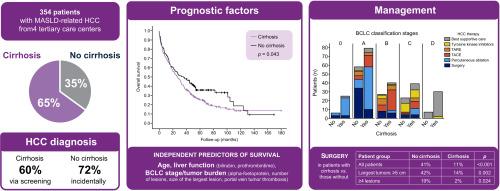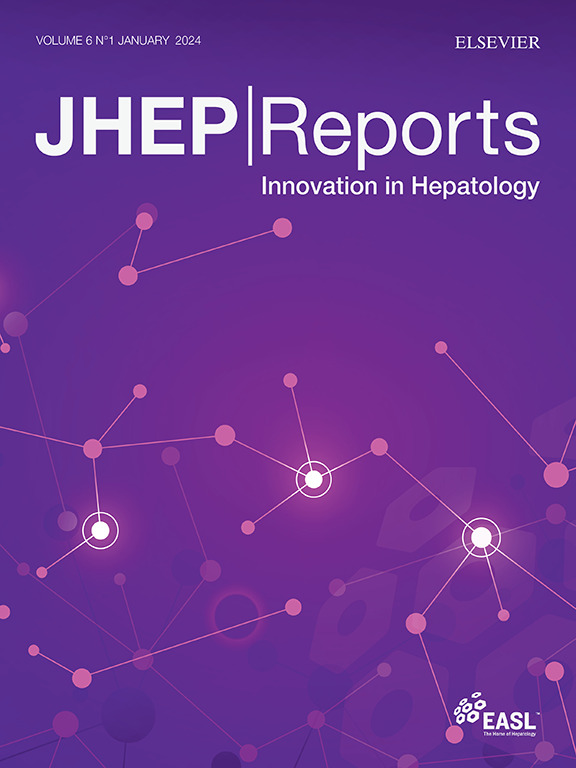MASLD 相关 HCC:比较有肝硬化和无肝硬化患者的多中心研究
IF 9.5
1区 医学
Q1 GASTROENTEROLOGY & HEPATOLOGY
引用次数: 0
摘要
背景& 目的尽管肝细胞癌(HCC)的发病率越来越高,但在非肝硬化肝脏中与代谢功能障碍相关性脂肪性肝病(MASLD)有关的肝细胞癌(HCC)的特征仍不十分明确。我们在一个大型多中心队列中比较了有或无基础肝硬化患者中与 MASLD 相关的 HCC 的特征、管理、存活率和趋势。研究纳入了 2007 年至 2018 年间在法国四所大学医院肝脏肿瘤会议上报告的 354 例与 MASLD 相关的 HCC。数据来自会议数据库和法国出生与死亡登记处。结果在HCC病例中,35%的病例在没有肝硬化的情况下发生。60%的肝硬化患者是通过筛查确诊的,72%的非肝硬化患者是偶然确诊的。与肝硬化患者相比,无肝硬化患者年龄更大,肿瘤负荷更大,但肝功能更好。无肝硬化患者的总生存率高于有肝硬化的患者(P = 0.043)。然而,肝硬化与总生存率并无独立关联,年龄、肝功能、肿瘤负荷和BCLC分类才是独立的预测因素。未患肝硬化的患者比患肝硬化的患者更常接受手术治疗(41% 对 11%,p <0.001),即使在最大肿瘤≥5 厘米(42% 对 14%,p = 0.002)或有四个或更多病灶(19% 对 2%,p = 0.024)的情况下也是如此。在接受手术的患者(有/无肝硬化)中,存活率没有显著差异。结论 在MASLD相关HCC病例中,无肝硬化患者占35%,他们的预后较差(年龄较大、肿瘤较大),但肝功能较好,因此与肝硬化患者相比,晚期肿瘤的治疗更积极,生存率更高。影响和意义:预计到2030年,与代谢功能障碍相关性脂肪性肝病(MASLD)有关的肝细胞癌(HCC)发病率将增加47%至130%,其中三分之一的病例发生在非肝硬化肝脏,使其无法接受筛查,因此更有可能在晚期阶段被诊断出来。我们的研究表明,MASLD 相关 HCC 患者的存活率取决于年龄、肿瘤负荷和基础肝功能,而这些非肝硬化患者的肝功能得以保留,因此可以对他们进行手术治疗。更好地了解非肝硬化MASLD患者发生HCC的病理生理过程将有助于指导这些患者的筛查和早期治疗。本文章由计算机程序翻译,如有差异,请以英文原文为准。

MASLD-related HCC: Multicenter study comparing patients with and without cirrhosis
Background & Aims
Despite its growing incidence, hepatocellular carcinoma (HCC) related to metabolic dysfunction-associated steatotic liver disease (MASLD) in non-cirrhotic livers remains poorly characterized. We compared the characteristics, management, survival, and trends of MASLD-related HCC in patients with or without underlying cirrhosis in a large multicenter cohort.
Methods
A total of 354 cases of MASLD-related HCC presented at the liver tumor meetings of four French university hospitals between 2007 and 2018 were included in the study. Data were extracted from the meetings’ databases and from the French Birth and Death Registry.
Results
Of HCC cases, 35% occurred in the absence of cirrhosis. HCC was diagnosed through screening in 60% of patients with cirrhosis, and incidentally in 72% of patients without it. Patients without cirrhosis were older, had a greater tumor burden, but also better liver function than patients with cirrhosis. Patients without cirrhosis showed better overall survival than those with cirrhosis (p = 0.043). However, cirrhosis was not independently associated with overall survival, the independent predictors were age, liver function, tumor burden and BCLC classification. Patients without cirrhosis underwent surgery more frequently than patients with cirrhosis (41% vs. 11%, p <0.001), even in cases where the largest tumors were ≥5 cm (42% vs. 14%, p = 0.002) or there were four or more lesions (19% vs. 2%, p = 0.024). Among the patients (with/without cirrhosis) who underwent surgery, survival was not significantly different. The cirrhosis/no cirrhosis ratio remained stable over the study period.
Conclusions
In MASLD-related HCC, patients without cirrhosis account for 35% of cases and have poor prognostic factors (higher age and larger tumors) but also better liver function, resulting in more aggressive management of advanced tumors and better survival compared to patients with cirrhosis.
Impact and implications:
The incidence of hepatocellular carcinoma (HCC) related to metabolic dysfunction-associated steatotic liver disease (MASLD) is projected to increase by 47% to 130% by year 2030 with one-third of cases occurring in non-cirrhotic livers, making them inaccessible to screening and therefore more likely to be diagnosed at an advanced stage. Our study shows that survival in patients with MASLD-related HCC depends on age, tumor burden and underlying liver function and the preserved liver function of these non-cirrhotic patients allows them to be managed surgically. A better understanding of the pathophysiological processes driving HCC occurrence in patients with non-cirrhotic MASLD will help guide the screening and early management of these patients.
求助全文
通过发布文献求助,成功后即可免费获取论文全文。
去求助
来源期刊

JHEP Reports
GASTROENTEROLOGY & HEPATOLOGY-
CiteScore
12.40
自引率
2.40%
发文量
161
审稿时长
36 days
期刊介绍:
JHEP Reports is an open access journal that is affiliated with the European Association for the Study of the Liver (EASL). It serves as a companion journal to the highly respected Journal of Hepatology.
The primary objective of JHEP Reports is to publish original papers and reviews that contribute to the advancement of knowledge in the field of liver diseases. The journal covers a wide range of topics, including basic, translational, and clinical research. It also focuses on global issues in hepatology, with particular emphasis on areas such as clinical trials, novel diagnostics, precision medicine and therapeutics, cancer research, cellular and molecular studies, artificial intelligence, microbiome research, epidemiology, and cutting-edge technologies.
In summary, JHEP Reports is dedicated to promoting scientific discoveries and innovations in liver diseases through the publication of high-quality research papers and reviews covering various aspects of hepatology.
 求助内容:
求助内容: 应助结果提醒方式:
应助结果提醒方式:


